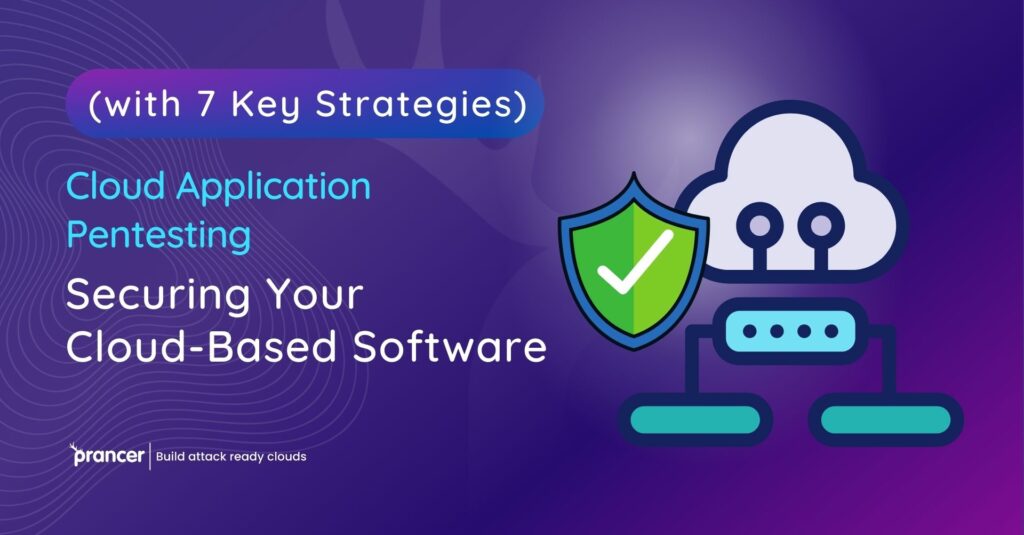

The emergence of cloud-based platforms as dominant players in the IT landscape has significantly transformed the cybersecurity domain. As these platforms gain traction, so does the imperative for robust security measures, specifically cloud application pentesting. Dive into this enlightening discourse on mastering the realm of cloud application pentesting, with an insight into Prancer’s pioneering role in this journey. Additionally, understand the profound impact of automated penetration testing in modern cybersecurity practices.
Prancer, a vanguard in the cloud security domain, accentuates the efficacy of your cloud application pentesting endeavors:
Automated penetration testing, in the realm of cloud application pentesting, simulates authentic cyber threats, proffering instantaneous feedback on vulnerabilities and configuration anomalies. This automated dynamism speeds up the pentesting cadence, ensuring a meticulous and swift assessment.
With cloud platforms taking over the IT world, it’s really important to do strong testing of apps in clouds. This change in cybersecurity is about carefully checking cloud-based apps for weaknesses. This job is important to stop misuse and keep data safe. As more people use cloud apps because they are bigger and can grow, these become a favorite for hackers. This shows the need to test all areas of such applications properly on clouds thoroughly with different methods.
In this situation, old testing methods are used with special attention to unique parts of cloud areas like server-less designs and databases made for the cloud. The process for checking cloud apps with cyber attacks has steps like making a clear plan, seeing special risks in the clouds. We use tools just for security and act out real attack scenes to test how safe they are. It’s also very important to keep data safe and provide regular security updates.
Prancer’s job in this nature world is important. Its automatic checking tools are made for online spaces. They always check and find dangers as they happen in real-time. Prancer makes sure that safety rules are followed and gives constant watch, improving the security of cloud-based apps. Automated testing for breaking in, symbol of the future of security on computers and networks. It helps check safety quicker and better, adjusting to how cloud apps change with time or threats are growing.
Automated Penetration Test in Revolutionizing Cloud Application Security.
The Cloud-First Cybersecurity Enviroment requires adaptation.
With the development of IT, cloud-based platforms have assumed a leading role in redefining cybersecurity terrain. With the advent of these cloud platforms, particularly Amazon Web Services (AWS), acute need for robust security measures in respect to application on such clouds has also grown. This analysis focuses on the crucial aspect of cloud application penetration testing, demonstrating Prancer’s pioneering role in this realm and the revolutionary effect that automated penetration testing brings with it.
The Importance of Cloud Application Penetration Testing
In the age of digital era, cloud application penetration testing is crucial because it serves as a comprehensive inspection that identifies possible weaknesses in applications hosted on the Cloud. This critical process prevents malicious entities from exploiting applications and preserving data integrity and user trust.
The Rise of Cloud-Based Software
Cloud applications have become the essence of contemporary digital infrastructure that provides scalability and ubiquity. But achieving this also makes them an ideal object for cyberattacks, which underscores the importance of broad penetration testing aimed at cloud environments.
Cloud vs. Traditional Pentesting: A Comparative Analysis
Although penetration testing principles are standard, cloud pentesting requires particular approaches to address peculiarities of vulnerabilities in the clouds. This involves paying attention to serverless architectures, containerized environments and cloud-native databases only found on the different types of clouds that are available.
Cloud Application Pentesting – A Strategic Approach
Scope and Planning:
Start with a specific definition of the scope that includes all digital assets in cloud environment for completeness analysis.
Risk Analysis:
Distinguish and define what threats pose to cloud applications, performing its pentesting process carefully.
Utilizing Specialized Tools:
Use security tools created for cloud ecosystems to understand the underlying causes of vulnerable points in a deep way.
Simulating Real-World Attacks:
Hire skilled penetration testers who carry out real life cyberattack situations, uncovering hidden weaknesses.
Data Protection Focus:
Focus on data protection by implementing strong encryption protocols and adhering to regulatory requirements.
Continuous Security Updates:
Consistently improve and upgrade cloud software to address the identified threats and increase security measures.
Incident Response Strategy:
Design an incident response plan for the cloud and include details on post-security breach actions along with communication protocols.
Prancer’s Groundbreaking Innovations in Cloud Security
Prancer stands at the forefront of cloud security, significantly enhancing cloud application penetration testing:
Automated Assessments: Prancer’s sophisticated automated resources continuously scan cloud security operations to provide details about any vulnerability and compliance with standards.
Security Policy Enforcement: Prancer guarantees uniform security compliance, eliminating risks throughout the cloudscape.
Ongoing Security Monitoring: But Prancer goes beyond mere pentesting and ensures that real-time monitoring of emerging threats is conducted, maintaining continuous security surveillance.
The Future of Cybersecurity: Automated Penetration Testing
The application of automated penetration testing is the future in cybersecurity for cloud applications. This method:
Enhances Speed and Accuracy: It automates the testing process with quick and accurate feedback about vulnerabilities concerning configuration matters.
Adapts to Evolving Threats: It maintains flexibility and adaptability to the dynamism of cloud landscapes, as well new security threats that surface constantly.
Embracing Automated Cloud Pentesting
Today in the cloud-focused IT landscape, comprehensive and effective penetration testing of clouds is essential. Automated penetration testing, which can be exemplified by Prancer’s tools is a proactive method of securing cloud environments. This merging of sophisticated technology with strategic cybersecurity techniques guarantees that cloud applications not only meet the compliance requirement but are resilient against advanced cyber threats. Prancer offers specialized automated tools designed specifically for cloud infrastructures that scan continuously and detect threats immediately, thereby converting cloud pentesting from one of routine compliance into a proactive security tool. With the advancements in cloud technologies, acceptance of automated penetration testing will become a critical tool to safeguard digital properties and preserve strong security within the clouds.
Conclusion
In summary, in light of the ever changing cloud dominant IT landscape, the importance of automated penetration testing for securing and building resilience in cloud applications cannot be overlooked. Solutions like Prancer’s automated penetration testing tools are at this very front, and make cloud application pentesting not a regular check but a proactive, breathing mechanism. New such technologies, organisations can effectively resist the current spectrum of cyber threats and actually protect their digital assets while continuing to trust their users. This marriage of technology and strategy represents a new dawn in cybersecurity, where emphasis transitions from just compliance to a preemptive, ongoing watch in the cloud-first cybersecurity realm.
cloud application pentesting is the linchpin in safeguarding your cloud-operated software. By actualizing the outlined strategies, integrating Prancer’s cloud protection suite, and embracing automated penetration testing, you’re poised to shield your cloud apps from looming cyber threats. As we navigate this perpetually evolving digital cosmos, an anticipatory and exhaustive stance on cloud application security remains your stalwart shield against cyber intrusions and data compromises.